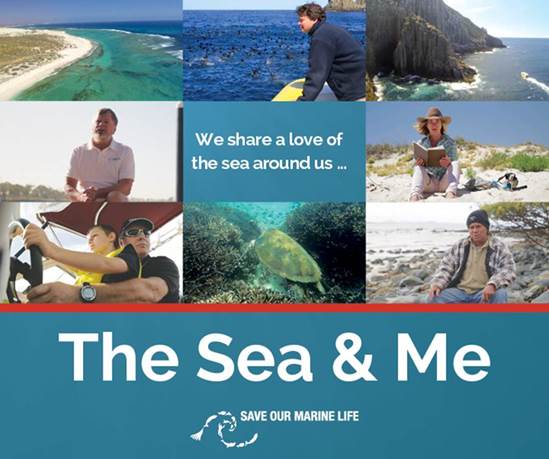We Are All Caretakers of Our Oceans
"The Sea & Me" documents the strong support for marine sanctuaries around Australia
Australia, with our unspoilt, sun-drenched beaches and healthy coastal lifestyle, historically has enjoyed a global reputation for responsible stewardship of the oceans. That’s in part because more than eight of 10 Australians live within 50 kilometers (31 miles) of the coast, and many of us share an enthusiasm for the beauty, bounty, and recreation opportunities that the marine environment provides.
That special bond is the focus of a new film, "The Sea & Me," which has played to capacity audiences in 16 communities nationwide since it debuted in Cairns on February 3.
The 30-minute film documents the experiences of people living and working close to sanctuaries for marine life. From Ningaloo Reef in Western Australia and Maria Island in Tasmania to the Great Barrier Reef and New South Wales coast, each of the reserves featured in the film is a world-class example of conservation and recreation interests working hand-in-hand. The sanctuaries, established more than a decade ago, allow marine life to flourish, help businesses to thrive, and preserve beautiful, natural areas for recreational pursuits.
The film
“The Sea & Me” showcases stories from a range of Australians, including business owners, divers, commercial and recreational fishers, and scientists. One of them is sheep farmer Leonie McLeod.
Four generations of the McLeod family live at Warroora Station, where the World Heritage-listed Ningaloo Marine Park meets Western Australia’s coast. Leonie reveals why she became a caretaker of the sea.
“I’ve had a pretty good look around the world, and I’ve just noticed that there [are] no places that are still as wild and beautiful [as Ningaloo], adjacent to a pristine coral reef, anywhere,” she says.
McLeod’s relationship with the ocean is mirrored in the experiences of others in the film.
Recreational angler Bill Sawynok, from Rockhampton on the central Queensland coast, has always wanted anglers to enjoy their passion but also feels that he and others in the fishing community would benefit from a better understanding of fish populations and the marine ecosystem.
So he established the Rocky Barra Bounty, a fishing derby on the Fitzroy River, to train his mates how to target, identify, and record fish species. This led to the development of one of the world’s largest citizen-science fish databases, which contributed to the design of sanctuary areas on the Great Barrier Reef.
As Sawynok says, “Sanctuary zones play an important role in looking after our fish resources. If nothing else, they act as an insurance policy.”
Why we need ‘The Sea & Me’ now
Some opponents of marine sanctuaries have suggested that there is no sound scientific basis for protecting the areas and that they, in fact, adversely affect Australians, particularly fishers. But this film shows that marine sanctuaries are backed by an eclectic array of Australians, including many who have not traditionally supported conservation initiatives.
Among these surprising supporters are commercial fisherman Dane Quirk, dive business owner Richard Nicholls, and commercial-fisher-turned-tourism-operator Rob Pennicott.
The film also documents some of the most compelling scientific evidence of marine sanctuary benefits. For example, in the Maria Island Marine Reserve off of Tasmania’s east coast, scientists have recorded a more than tenfold increase in the number of lobsters inside the sanctuary area over the past decade. Lobsters breeding in the sanctuary are moving beyond its boundaries into surrounding waters, to the great delight of local anglers.
The resurgent lobster population has also repelled an encroachment by sea urchins spreading south into Tasmania’s waters. Lobsters prey on urchins, which eat kelp; unchecked urchin populations can decimate kelp beds, a source of critical habitat for other endemic species.
Farther north, in the tropical waters of the Great Barrier Reef, James Cook University researcher David Williamson is leading groundbreaking research focused primarily on coral trout, a popular target of recreational anglers.
Williamson’s work reveals the enormous range of trout fingerlings born in the sanctuary area of the reef. His team has shown that the biodiversity that initially flourishes within the sanctuary extends beyond its boundaries, thus significantly bolstering the abundance and diversity of life elsewhere on the Great Barrier Reef.
All the people profiled in “The Sea & Me” regard themselves as caretakers of the oceans. As I have traveled around Australia meeting with members of local communities, I’ve seen the same commitment to safeguarding the extraordinary richness of life in and around our oceans. As you watch this film, I hope you will see that marine sanctuaries enrich people’s lives, benefit local economies, and help extend a proud legacy for all Australians. And that is something worth protecting.
This video is hosted by YouTube. In order to view it, you must consent to the use of “Marketing Cookies” by updating your preferences in the Cookie Settings link below. View on YouTube
This video is hosted by YouTube. In order to view it, you must consent to the use of “Marketing Cookies” by updating your preferences in the Cookie Settings link below. View on YouTube







